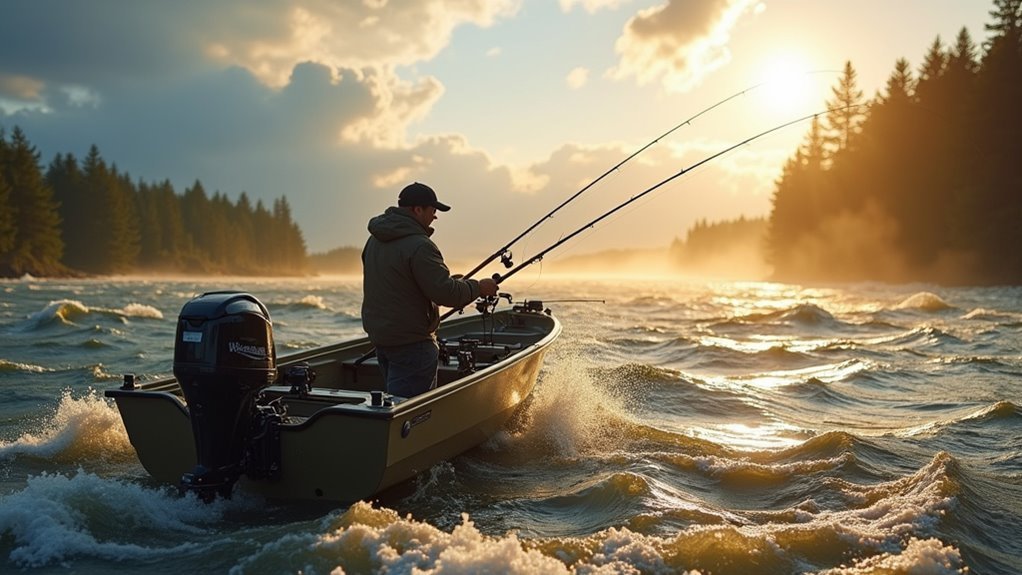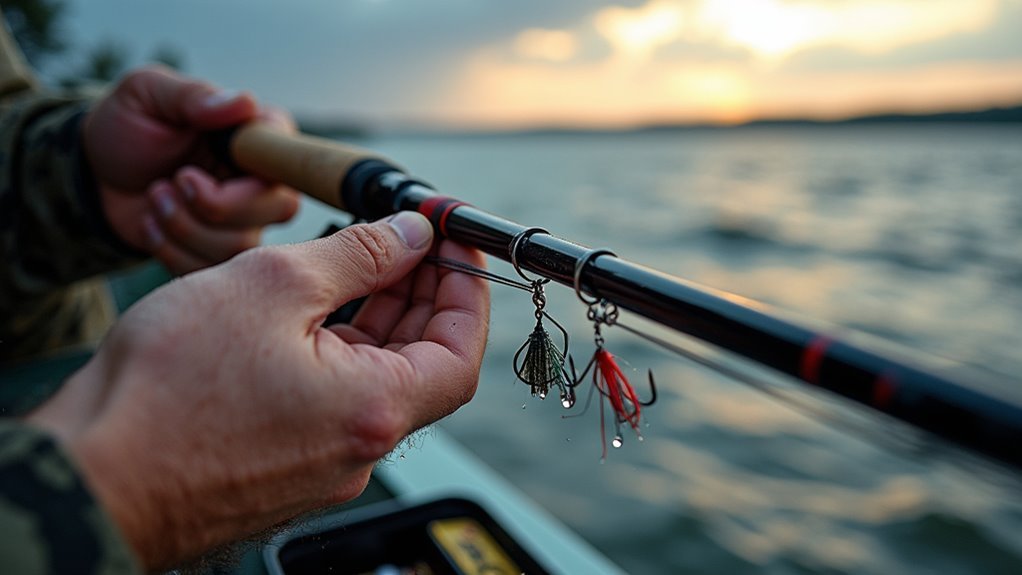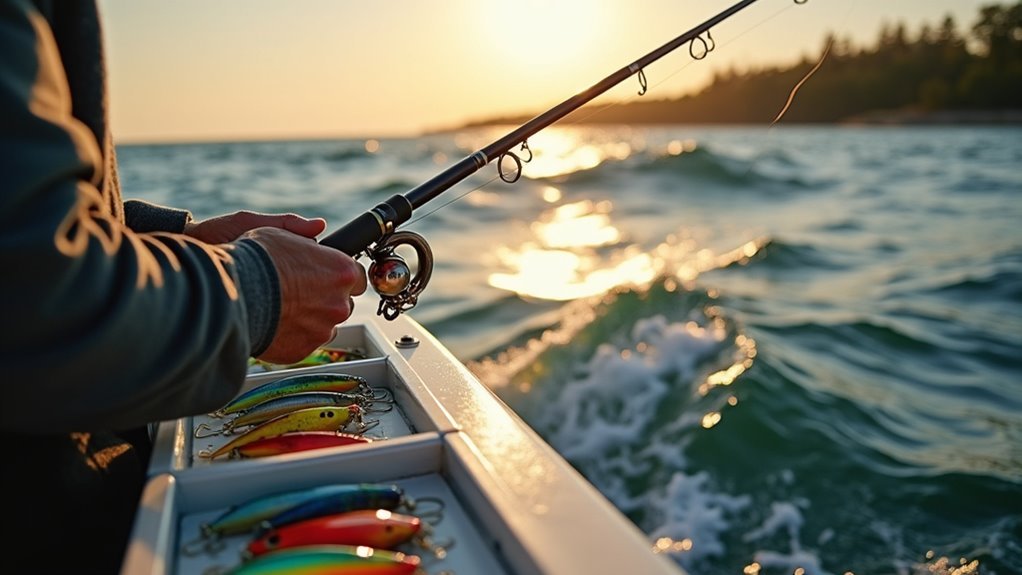When the wind picks up, don’t pack away your gear! We’ve found that breezy days often deliver the season’s best catches. Wind stirs up plankton and baitfish, attracting hungry predators. The choppy water reduces visibility, making fish less likely to spot us. We control our boats by positioning sideways to the wind, use heavier lures, and opt for thinner line to cut through resistance. The secrets to windy day success await those who stay when others leave.
Why Wind Creates Better Fishing Opportunities

While many anglers pack up their gear when the wind starts to howl, they’re actually missing out on some of the best fishing opportunities. Wind works like nature’s dinner bell for fish. It stirs up the water, pushing plankton around, which attracts baitfish and then larger predators.
We’ve noticed that on breezy days, walleye become particularly active since the choppy surface blocks light penetration. This reduced visibility works in our favor too—fish can’t spot us as easily. Last summer, we landed three monster bass during a gusty afternoon when everyone else had left the lake. Additionally, aligning the boat with wind compensation ensures smoother rides and enhances our ability to target those active fish effectively.
Essential Boat Control Strategies in Windy Conditions

Once the wind kicks up, mastering your boat becomes just as important as knowing where the fish are hiding. We’ve all been there—fighting the wind while trying to keep our line in the sweet spot. Proper positioning can make or break your fishing day.
- Use your electric motor to drive into the wind, giving you better control and slower drift.
- Deploy drift paddles or a drift sock when winds are howling to slow your movement.
- Position your boat sideways to the wind for ideal casting angles and minimal resistance. Additionally, consider optimizing your trolling motor efficiency to extend battery life and maintain consistent performance in challenging conditions.
Tackle Modifications to Master Blustery Days

As the wind whips across the water, your standard tackle setup might leave you frustrated and fish-less. We’ve learned to adapt our gear on those blustery days when the lake looks more like an ocean.
| Tackle Component | Windy Day Modification |
|---|---|
| Line | Thinner diameter to cut wind |
| Weights | Add 10-30% more weight |
| Lures | Heavier options with good action |
| Jigs | Compact profiles that resist wind |
Remember when we tried casting those lightweight jigs last season during that sudden gust? They practically flew backward! Now we always pack fluorocarbon line and heavier lures whenever the forecast shows wind. Keeping an eye on your battery health and age can also ensure your trolling motor performs well in challenging conditions.
Top Lure Selections When the Wind Kicks Up

Now that we’ve adjusted our gear for the wind, let’s talk about what to tie on when those gusts start howling. Wind changes everything, including what fish are willing to strike. We’ve caught monsters on blustery days using the right lures.
While others head for shore when the wind kicks up, seasoned anglers know that’s when the big ones come out to play.
- Crankbaits with tight wobbles cut through choppy water beautifully and their rattles help fish locate them when visibility drops.
- Spinnerbaits create flash and vibration that trigger reaction strikes when wind stirs up the shallows.
- Heavier jerkbaits work wonders when paused briefly, mimicking struggling baitfish in wind-churned waters. Additionally, using a trolling motor can help maintain control in windy conditions, allowing for more precise casting.
Frequently Asked Questions
How Does Wind Direction Affect Fish Positioning Around Structure?
We’ll find fish on the windward side of structures where food collects and turbulence creates feeding opportunities. They’ll position themselves upwind to ambush prey while using structure for both protection and hunting advantage.
Can Night Fishing Be More Productive During Windy Periods?
Yes, we’ve found that night fishing during breezy periods can be quite fruitful. Wind’s challenges often subside after dark, while its benefits—stirring up the food chain and reducing fish visibility—continue to work in our favor.
Do Different Fish Species React Differently to Wind Conditions?
Yes, fish species react differently to wind. We’ve noticed that light-sensitive species like walleye become more active, while bass move to shallower waters during wind. Each species adapts uniquely to changing conditions.
What Wind Speed Is Too Dangerous for Fishing Safely?
Like rolling dice with Neptune, we’re flirting with danger when winds exceed 20 mph. We’d advise heading back to shore at 15-20 mph as boat control becomes difficult and safety risks outweigh fishing benefits.
How Do Seasonal Patterns Change Windy Day Fishing Strategies?
In spring, we’ll focus on shallow windblown banks where fish spawn. Summer requires targeting windward points for oxygen. Fall means following baitfish pushed by wind, while winter demands fishing protected areas on less windy days.
Conclusion
When most anglers are heading home, we’re just gearing up. Wind-churned waters are like nature’s dinner bell, calling fish to feast. We’ve transformed what many consider a nuisance into our secret weapon. By mastering boat positioning, adjusting our tackle, and choosing the right lures, we’ve turned blustery conditions into our most productive fishing days. So next time the forecast shows wind, don’t hide—it might just be your best day on the water!